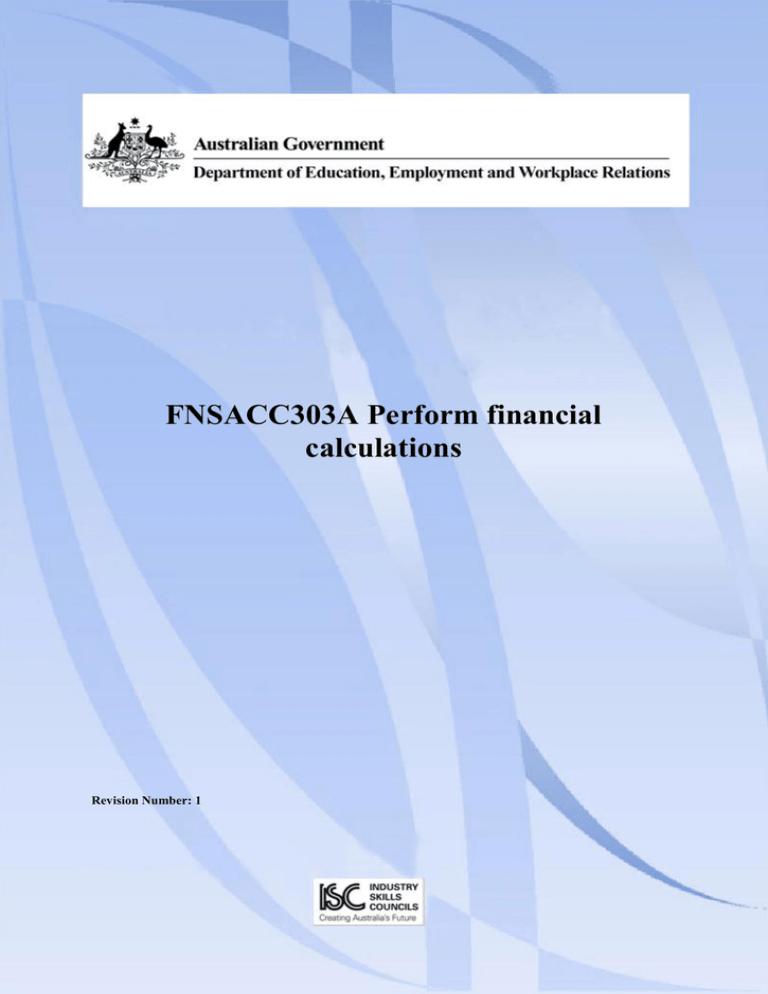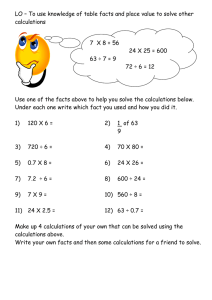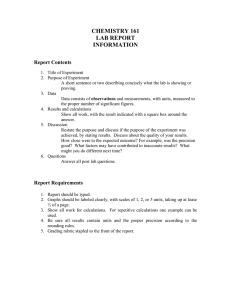FNSACC303A Perform financial calculations
advertisement

FNSACC303A Perform financial calculations Revision Number: 1 FNSACC303A Perform financial calculations Date this document was generated: 27 May 2012 FNSACC303A Perform financial calculations Modification History Not applicable. Unit Descriptor Unit descriptor This unit covers the use of a common range of calculation methods and techniques for conducting routine financial calculations and transactions. No licensing, legislative, regulatory or certification requirements apply to this unit at the time of endorsement. Application of the Unit Application of the unit This unit requires the application of literacy and numeracy skills to perform common computational tasks as part of an operational job role. Licensing/Regulatory Information Not applicable. Pre-Requisites Prerequisite units Employability Skills Information Employability skills Approved © Commonwealth of Australia, 2012 This unit contains employability skills. Page 2 of 7 Innovation and Business Skills Australia FNSACC303A Perform financial calculations Date this document was generated: 27 May 2012 Elements and Performance Criteria Pre-Content Elements describe the essential outcomes of a unit of competency. Performance criteria describe the performance needed to demonstrate achievement of the element. Where bold italicised text is used, further information is detailed in the required skills and knowledge section and the range statement. Assessment of performance is to be consistent with the evidence guide. Elements and Performance Criteria ELEMENT PERFORMANCE CRITERIA 1. Obtain data and resources for financial calculations 1.1. Input data is obtained and verified as relevant for workplace calculations 1.2. Outcomes of calculations are determined and confirmed from task specifications 1.3. Relevant resources and equipment to perform the calculations effectively are acquired 1.4. Simple spreadsheets are developed where necessary to perform calculations that may be repeated 2. Select appropriate methods and carry out financial calculations 2.1. Hand held calculators are primarily used for performing calculations with other equipment that may be required identified and obtained as necessary 2.2. Calculations to complete the work requirements are performed using appropriate techniques 2.3. Data used in calculations is rechecked against task specifications 3. Check calculations and record outcomes 3.1. Results are checked to ensure the calculations are accurate, meet the required outcomes with common computational errors recognised and corrected where required 3.2. Calculation results are recorded to industry standards and enterprise requirements 3.3. Calculation worksheets are stored or electronically filed for future use Approved © Commonwealth of Australia, 2012 Page 3 of 7 Innovation and Business Skills Australia FNSACC303A Perform financial calculations Date this document was generated: 27 May 2012 Required Skills and Knowledge REQUIRED SKILLS AND KNOWLEDGE This section describes the skills and knowledge required for this unit. Required skills ability to communicate effectively with co-workers and supervisors in order to clarify information basic numeracy skills data entry skills IT skills for accessing and using appropriate software such as spreadsheets and databases and using internet information questioning/listening techniques time management skills written communication skills necessary to complete business documentation Required knowledge relevant financial services legislation and statutory requirements relevant knowledge of organisation policy on record keeping and filing Approved © Commonwealth of Australia, 2012 Page 4 of 7 Innovation and Business Skills Australia FNSACC303A Perform financial calculations Date this document was generated: 27 May 2012 Evidence Guide EVIDENCE GUIDE The Evidence Guide provides advice on assessment and must be read in conjunction with the performance criteria, required skills and knowledge, range statement and the Assessment Guidelines for the Training Package. Overview of assessment Critical aspects for assessment and evidence required to demonstrate competency in this unit Evidence of the ability to: Context of and specific resources for assessment Assessment must ensure: Method of assessment use sound written communication skills understand and apply mathematical techniques and methods of calculation effectively use relevant data entry, office equipment and software check for accuracy of computational results record calculation worksheets used for future reference and use. competency is demonstrated in the context of the work environment and conditions specified in the range statement either in a relevant workplace or a closely simulated work environment access to and the use of a range of common office equipment, technology, software and consumables hand held calculators financial services industry documentation and specialist software access to IT systems and databases. A range of assessment methods should be used to assess practical skills and knowledge. The following examples, in combination, are appropriate for this unit: evaluating an integrated activity which combines the elements of competency for the unit or a cluster of related units of competency verbal or written questioning on underpinning knowledge and skills which may include formal examinations evaluating samples of work Guidance information for assessment Approved © Commonwealth of Australia, 2012 Page 5 of 7 Innovation and Business Skills Australia FNSACC303A Perform financial calculations Date this document was generated: 27 May 2012 Range Statement RANGE STATEMENT The range statement relates to the unit of competency as a whole. It allows for different work environments and situations that may affect performance. Bold italicised wording, if used in the performance criteria, is detailed below. Essential operating conditions that may be present with training and assessment (depending on the work situation, needs of the candidate, accessibility of the item, and local industry and regional contexts) may also be included. Input data may include: Workplace calculations include: basic loan calculations compound interest credit interest Goods and Services Tax (GST) calculations inflation effects mark up and break even simple interest straight-line deprecation. hand held calculators Resources and equipment must include: and may include: Appropriate techniques include: Common computational errors may include: Approved © Commonwealth of Australia, 2012 client records enterprise tables and associated documentation industry and government data and statistics such as: tax tables compound interest tables loan calculators depreciation factors. computers financial services software spreadsheets on-ine special purpose calculators. division addition subtraction percentages fractions decimals straight-line graphs. input/transcription errors wrong spreadsheet function or formula used incorrect methodology Page 6 of 7 Innovation and Business Skills Australia FNSACC303A Perform financial calculations Date this document was generated: 27 May 2012 RANGE STATEMENT wrong computational sign incorrect order of operations loss of constants incorrect positioning of decimal points and brackets in equations. Unit Sector(s) Unit sector Accounting Competency field Competency field Co-requisite units Co-requisite units Approved © Commonwealth of Australia, 2012 Page 7 of 7 Innovation and Business Skills Australia



